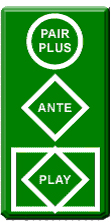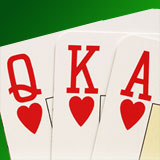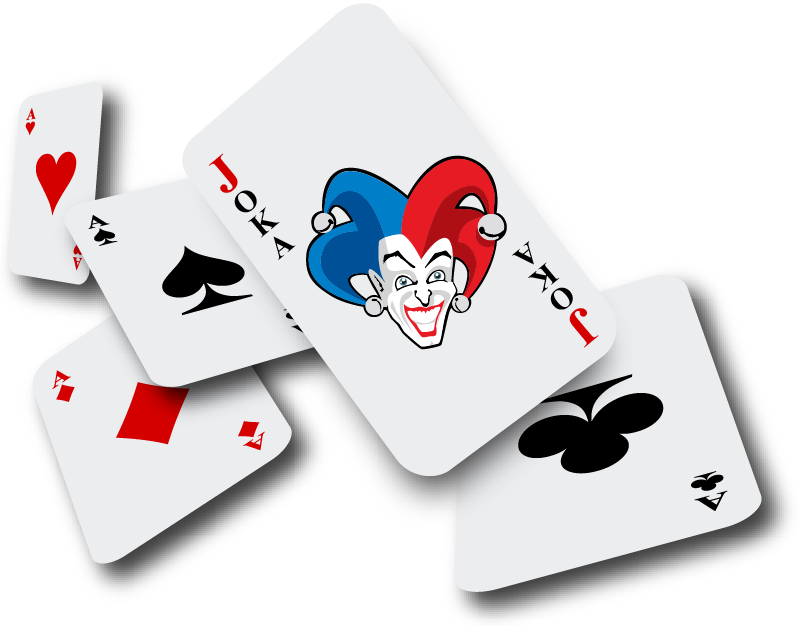Three Card Poker is a relatively new game, and it has quickly become very popular because it’s easy to play and a lot of fun! Played with a single regulation deck of 52 cards, Three Card Poker is actually two games in one. You can make an Ante/Play bet in which you are hoping your three card hand is higher than the dealer’s three card hand; you can also make a Pair Plus bet in which you’re wagering on whether you’ll be dealt a pair or better. You can make either the Ante/Play bet or the Pair Plus bet alone, or you can make both bets – it’s up to you.

The Three Card Poker table layout
In front of each player you’ll see three betting boxes. The top box (or circle, actually) is the Pair Plus – that’s where you’ll put your chip if you want to make the Pair Plus bet. Beneath that are two more boxes — one labeled Ante, and the other labeled Play. On most Three Card Poker table layouts you’ll also see a listing of possible winning hands, and what the bonus payouts would be for each (more on this later).
Playing the game
The game starts with you placing a chip or chips in the Pair Plus and/or Ante box. After all the players have made their initial bets, the dealer will deal each player and himself three cards, all face down. You’re allowed to pick up your cards and take a look. If you made the Pair Plus bet only, you’ll know whether you won or lost simply by looking at your cards – you simply need a pair or better to win, as your Pair Plus bet isn’t affected by what the dealer has. If you’ve made the Ante bet, you have a decision to make…
The Ante/Play bet
Once you’ve bet on the Ante and looked at your three card hand, you must decide whether you want to continue playing, or whether you want to fold. (Remember, this happens before the dealer shows his hand.) If you decide that your hand is weak and that you’ll probably lose to the dealer, you fold your hand and forfeit your Ante bet. If you think you might have a better hand than the dealer, and want to play, you must make an additional bet in the Play box equal to your Ante bet.
After all the players have made their decisions, the dealer will turn over his hand. The dealer must “qualify” with a hand of Queen or higher for play to continue. If the dealer’s hand does not contain a Queen or higher all players still in the hand will be paid even money for their Ante wager, while their original bet on the Play will be returned to them.
If the dealer’s hand does qualify, he will compare it to each player’s hand. If the dealer’s hand beats your hand, you lose both your Ante and your Play bets. If your hand beats the dealer’s hand, you will be paid even money on your Ante and Play bets. However, if you have a really strong hand, the dealer will pay you an “Ante Bonus.”
The Ante Bonus

If you were dealt a straight, a three-of-a-kind, or a straight flush, you will be paid a bonus — whether or not your hand beats the dealer’s hand. These bonus payouts are typically printed right on the table layout. For a straight you will be paid 5 to 1 on your Ante bet; for three of a kind you will be paid 10 to 1; for a straight flush you’ll rake in 30 to 1 on your Ante bet!
The Pair Plus bet
As we mentioned earlier, for the Pair Plus bet it doesn’t matter if the dealer qualifies – or even if he has a better hand than you. If your hand has a pair or better, you win your Pair Plus bet. If your hand does not have at least a pair, you lose your Pair Plus bet.
Tips and strategy
If you’ve made your Ante bet, it’s a good rule of thumb to fold (and not make your Play bet) if your hand is lower than Q-6-4. If your hand is at least Q-6-4 or better, go ahead and make your Play bet. If you’re interested in making the Pair Plus bet, keep in mind that in a three card hand, statistics say you can expect to be dealt a pair or better roughly 25 percent of the time.

